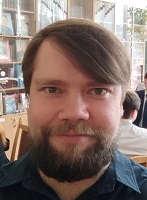Spatial model in the Tuvan and Old English heroic epics
DOI:
https://doi.org/10.25178/nit.2023.3.7Keywords:
epos; Tuvan heroic epics; Beowulf; category of space; spatial modelAbstract
The article deals with spatial representations which, firstly, are basic in the human thinking consciousness and, secondly, form each ethnic group’s own model of the world. The relevance of the research is determined by the necessity of ethno-identification of cultural and historical concepts in the era of globalization. An interpenetration of cultures, which sometimes erases ethnocultural features and archetypical signs, is typical for this process. The aim of the study is to find out linguistic means of actualizing spatial relations in Tuvan and Old English epics.
The study is carried out through the analysis of lexemes which represent the universal category of space. Its most important components originated in the archaic worldview and are imprinted in the epics. Such characteristics of space as partition, binary oppositions and measurement parameters constitute the cultural code and are determined by factors and conditions of living environment, traditions and customs. All these are manifested in the epic works of Tuvan and Anglo-Saxon peoples and allow to form an archetypical spatial model of the studied ethnos.
As a result of the study it has been found out that the spatial models of the world, reflected in the epic works of the Tuvans and Anglo-Saxons that belong to different national and cultural autonomies, have common features in the representation of the world as a trichotomous model, in orientation to the cardinal directions and coordinate axes, in the binary opposition between “native” and “alien” spaces. At the same time, we can highlight some distinctive features of the Tuvan epos with regard to spatial representations in relation to the human body and parameters of the way and space. The authors note the symbolism of color in the description of the cardinal points of the world and the indication of the sacred places in Tuvan tales. The analysis of the linguistic means of actualizing the category of space shows that each ethnic group has its own perception of space through its assimilation and reflection in the mythopoetic model of the world.
The linguoculturological approach to the study of epics of peoples of different origins allows to reveal ethnoses’ ideas about the world order and their world outlooks in the archaic period of development during which the foundations of ethnic culture and ethnocultural spirit were formed.
References
Baiburin, A. K. (1990) Ritual: svoe i chuzhoe [Ritual: One’s own and the different]. In: Fol'klor i etnografiia: problemy rekonstruktsii faktov traditsionnoi kul'tury [Folklore and ethnography: Issues of reconstruction of the facts of traditional culture] : A collection of research articles / ed. by B. N. Putilov. Leningrad, Nauka. 231, [2] p. Pp. 3–17. (In Russ.).
Baliasnikova, O. V. (2017) «Svoi — chuzhoi»: psikholingvisticheskie aspekty issledovaniia (na materiale russkogo iazyka) [“One’s own — the unfamiliar”: Psycholinguistic aspects of research (a case study of the Russian language)]. Moscow, Kantsler. 202 p. (In Russ.).
Bredis, M. A. (2023) Simvolika chisla deviat' v tuvinskoi lingvokul'ture (na fone riada tiurkskikh i mongol'skikh iazykov) [Symbolism of the number nine in Tuvan linguoculture (as compared to some Turkic and Mongolian languages)]. The New Research of Tuva, no. 1, pp. 228–242. (In Russ.). DOI: https://doi.org/10.25178/nit.2023.1.13
Brunova, E. G. (2007) Predstavleniia o svoei zemle v angliiskom iazyke i kul'ture [Visions of their own land in the English language and culture]. Vestnik Cheliabinskogo gosudarstvennogo universiteta, no. 15, pp. 33–42. (In Russ.).
Gvozdetskaya, N. Yu. (2010) Kontsept «put'» v poeticheskom tvorchestve anglosaksov (VII–XI vv.) [The concept of “path” in the poetic works of the Anglo-Saxons (7–11th c.)]. In: Drevneishie gosudarstva Vostochnoi Evropy, 2009 god: transkontinental'nye i lokal'nye puti kak sotsiokul'turnyi fenomen : materialy i issledovaniia [The earliest states of Eastern Europe. 2009: Transcontinental and local ways as a socio-cultural phenomenon] / ed. by T. N. Jackson. Moscow, Indrik. 496 p. Pp. 345–361. (In Russ.).
Grebnev, L. V. (1960) Tuvinskii geroicheskii epos (opyt istoriko-etnograficheskogo analiza) [Tuvan heroic epos (experience of historical and ethnographic analysis)]. Moscow, Vostochnaia literatura. 145 p. (In Russ.).
Kenin-Lopsan, M. B. (1987) Obriadovaia praktika i fol'klor tuvinskogo shamanstva. Konets XIX — nachalo XX v. [Ritual practice and folklore of Tuvan shamanism. Late 19th — early 20th century]. Novosibirsk, Nauka. 162, [2] p. (In Russ.).
Kononov, A. N. (1978) Semantika tsvetooboznachenii v tiurkskikh iazykakh [Semantics of color designations in the Turkic languages]. In: Tiurkologicheskii sbornik 1975 [Turkological collection, 1975] / ed. by A. N. Kononov. Moscow, Nauka ; Chief Editorial Board of Oriental Literature. 279 p. Pp. 159–179. (In Russ.).
Kravchenko, A. V. (2004) Iazyk i vospriiatie: kognitivnye aspekty iazykovoi kategorizatsii [Language and perception: Cognitive aspects of language categorization]. 2nd ed., revised. Irkutsk, Irkutsk State University Publ. 206 p. (In Russ.).
Kravchenko, E. V. (2022) Semanticheskoe razvitie slov v epicheskom narrative: na primere oboznachenii moria v «Beovul'fe» [Semantic development of words in epic narration. The use of synonyms for sea in “Beowulf“]. In: RSUH/RGGU Bulletin. Series “Literary Theory. Linguistics. Cultural Studies”, no. 4, part 2, pp. 166–185. (In Russ.). DOI: https://doi.org/10.28995/2686-7249-2022-4-166-185
Lotman, Yu. M. (1996) Vnutri mysliashchikh mirov. Chelovek — tekst —semiosfera — istoriia [Inside the thinking worlds. Man — text — semiosphere —history]. Moscow, Iazyki russkoi kul'tury. 464 p. (In Russ.).
Lvova, E. L., Oktyabrskaya, I. V., Sagalaev, A. M. and Usmanova, M. S. (1988) Traditsionnoe mirovozzrenie tiurkov Iuzhnoi Sibiri. Prostranstvo i vremia. Veshchnyi mir [The traditional worldview of Turkic peoples of South Siberia. Space and time. Material world]. Novosibirsk, Nauka, Siberean Branch. 225 p. (In Russ.).
Meletinsky, E. M. (1975) Skandinavskaia mifologiia kak sistema [Scandinavian mythology as a system]. In: Trudy po znakovym sistemam, VII. Pamiati Petra Grigor'evicha Bogatyreva [Works on sign systems, VII. In memory of Pyotr Grigoryevich Bogatyrev] / ed. by Z. Mints. Tartu. 308 p. Pp. 38–51. (Scholarly Notes of Tartu State University. Issue 365). (In Russ.).
Meletinsky, E. M. (1976) Poetika mifa [The poetics of myth]. Moscow, Nauka. 407 p. (In Russ.).
Melnikova, E. A. (1987) Mech i lira: anglosaksonskoe obshchestvo v istorii i epose [Sword and lyre: Anglo-Saxon society in history and epic]. Moscow, Mysl'. 203, [2] p. (In Russ.).
Nevskaia, I. A. (2005) Prostranstvennye otnosheniia v tiurkskikh iazykakh Iuzhnoi Sibiri (na materiale shorskogo iazyka) [Spatial relations in the Turkic languages of Southern Siberia (a case study of the Shor language)]. Novosibirsk, Nika. 305 p. (In Russ.).
Nekliudov, S. Yu. (1972) Vremia i prostranstvo v byline [Time and space in bylina]. In: Slavianskii fol'klor [Slavic folklore] / ed. by B. N. Putilov and V. K. Sokolova. Moscow, Nauka. 328 p. Pp. 18–45. (In Russ.).
Nekliudov, S. Yu. (2000) Struktura i funktsiia mifa [Structure and function of the myth]. In: Mify i mifologiia v sovremennoi Rossii [Myths and mythology in contemporary Russia] / ed. by K. Eimermacher, F. Bomsdorf and G. Bordiugov. Moscow, AIRO-XX. 216 p. Pp. 17–38. (In Russ.).
Nekliudov, S. Yu. (2019) Fol'klornyi landshaft Mongolii. Epos knizhnyi i ustnyi [Folklore landscape of Mongolia. Literary and oral epic]. Moscow, Indrik. 592 p. (In Russ.).
Oktyabrskaya, I. V. (2012) Put' cherez perevaly. Kontseptsiia puti v fol'klorno-poeticheskoi traditsii Altaia [The way through the passes. The concept of the way in the folklore and poetic tradition of Altai]. Problemy istorii, filologii, kul'tury, no. 3 (37), pp. 325–334. (In Russ.).
Ondar, V. S. (2016) Otrazhenie kategorii prostranstva v tuvinskom iazyke (na materiale geroicheskogo eposa «Boktug-Kirish, Bora-Sheelei») [Reflection of the category of space in the Tuvan language: The case of the “Boktu-Kirish, Bora-Sheelei” heroic epic]. Filologicheskie nauki. Voprosy teorii i praktiki, no. 2 (56) : in 2 parts. Part 2, pp. 129–134. (In Russ.).
Orus-ool, S. M. (2001) Tuvinskie geroicheskie skazaniia (tekstologiia, poetika, stil') [Tuvan heroic legends (textual criticism, poetics and style)]. Moscow, MAKS Press. 424 p. (In Russ.).
Podosinov, A. V. (1999) Ex oriente lux! Orientatsiia po stranam sveta v arkhaicheskikh kul'turakh Evrazii [Ex oriente lux! Orientation on cardinal directions in archaic cultures of Eurasia]. Moscow, Iazyki russkoi kul'tury. 720 p. (In Russ.).
Propp, V. Ya. (1998) Poetika fol'klora [The poetics of folklore] / coll., foreword and comm. by A. N. Martynova. Moscow, Labirint. 352 p. (In Russ.).
Pukhov, I. V. (2004) Geroicheskii epos altae-saianskikh narodov i iakutskie olonkho [Heroic epic of the Altai-Sayan peoples and the Yakut olonkho] / afterword and comm by V. M. Nikiforov. Yakutsk, Siberian Branch of the RAS, Yakutsk Subbranch. 328 p. (In Russ.).
Semenova, L. N. (2006) Epicheskii mir olonkho: prostranstvennaia organizatsiia i siuzhetika. [The epic world of Olonkho: Spatial organization and plot]. St. Petersburg, Peterburgskoe vostokovedenie. 232 p. (In Russ.).
Smirnitskaia, O. A. (1982) Poeticheskoe iskusstvo anglosaksov [The poetic art of the Anglo-Saxons]. In: Drevneangliiskaia poeziia [Old English poetry] / ed. by M. I. Steblin-Kamenskii. Moscow, Nauka. 320 p. Pp. 171–232. (In Russ.).
Smirnitskaia, O. A. (2008) Dva predaniia o pervykh poetakh: Kedmon i Bragi [Two legends about the first poets: Caedmon and Bragi]. In: Smirnitskaia, O. A. Izbrannye stat'i po germanskoi filologii [Selected articles on Germanic philology]. Moscow, MAKS Press. 470, [1] p. Pp. 324–345. (In Russ.).
Stojanova, E. (2014) Iazykovaia lichnost' i vospriiatie mira v terminakh dikhotomii svoi — chuzhoi (na materiale russkoi i bolgarskoi frazeologii s komponentom ‘dom / strukturnye elementy doma’) [Linguistic personality and perception of the world in terms of the friend / foe dichotomy (a case study of Russian and Bulgarian phraseology with the component ‘house / structural elements of the house’)]. Verbum, vol. 5, pp. 195–204. (In Russ.). DOI: http://doi.org/10.15388/Verb.2014.5.5008
Tokmashev, D. M. (2012) Kategoriia prostranstva v shorskom geroicheskom epose: lingvokul'turologicheskii aspekt [Category of space in shor heroic epos: Aspects of language and culture]. Vestnik Tomskogo gosudarstvennogo universiteta. Filologiia, no. 3 (19), pp. 40–58. (In Russ.).
Toporov, V. N. (1983) Prostranstvo i tekst [Space and text]. In: Tekst: semantika i struktura [Text: Semantics and structure] / ed. by T. V. Tsivian. Moscow, Nauka. 302 p. Pp. 227–285. (In Russ.).
Toporov, V. N. (2010a) Mirovoe derevo: universal'nye znakovye kompleksy [The world tree: Universal sign complexes]. Moscow, Rukopisnye pamiatniki Drevnei Rusi. Vol. 1. 448 p. (In Russ.).
Toporov, V. N. (2010b) Mirovoe derevo: universal'nye znakovye kompleksy [The world tree: Universal sign complexes]. Moscow, Rukopisnye pamiatniki Drevnei Rusi. Vol. 2. 496 p. (In Russ.).
Toporova, T. V. (1994) Semanticheskaia struktura drevnegermanskoi modeli mira [Semantic structure of the ancient Germanic model of the world]. Moscow, Radiks. 190 p. (In Russ.).
Tuvintsy: rodnye liudi [Tuvans: Native people] (2022) : A multi-authored monograph / Ch. K. Lamazhaa, N. D. Suvandii, Sh. Yu. Kuzhuget and Sh. B. Mainy ; ed. by Ch. K. Lamazhaa and N. D. Suvandii. St. Petersburg, Nestor-Istoriia. 360 p. (In Russ.).
Khertek, L. D. (2018) Kontsept «prostranstvo» v epicheskoi kartine mira [The concept “space” in the epic world view]. Philology. Theory & Practice, no. 6–2 (84), pp. 402–407. (In Russ.). DOI: https://doi.org/10.30853/filnauki.2018-6-2.46
Elden, S. (2009) Place symbolism and land politics in “Beowulf”. Cultural Geographies, vol. 16, no. 4, pp. 447–463.
Nagler, M. N. (1980) “Beowulf” in the context of myth. In: Old English literature in context: Ten essays / ed. by J. D. Niles. Cambridge, D. S. Brewer ; Totowa, NJ, Rowman & Littlefield. 184 p. Pp. 143–156.
Niles, J. D. (2016) Old English literature: A guide to criticism with selected readings. Chichester, West Sussex, Malden, MA, Wiley-Blackwell. xv, 336 p.
Published
How to Cite
For citation:
Prosyannikova O. I., Skorik K. V. and Grebеnev A. N. Prostranstvennaia model’ v geroicheskom tuvinskom i drevneangliiskom epose [Spatial model in the Tuvan and Old English heroic epics]. New Research of Tuva, 2023, no. 3, pp. 97-124. (In Russ.). DOI: https://doi.org/10.25178/nit.2023.3.7
Issue
Section

This work is licensed under a Creative Commons Attribution-NonCommercial 4.0 International License.

Author(s) license holder(s) grant rights for their work to the journal (grantee of a license) under the simple non-exclusive open license in accordance with Art. 1286.1 «Open license for a research work, work of literature or fine arts», Civil Code of the Russian Federation.
New Research of Tuva publishes articles under the Creative Commons Attribution-NonCommercial license (CC BY-NC).
Since it is an open license, author(s) reserve the right to upload the article to their institutional repository, submit it to another journal (if it allows republications), or republish it on their own website (in full, or in part).
However, several conditions apply here:
a) The republished version must always contain the name(s) and affiliation(s) of the author(s), the original title and the hyperlink to the original version on the New Research of Tuva website;
b) It must be in open access, free of charge, and no category of readers must be in any way whatsoever advantaged over general readership.
c) should the contribution be submitted elsewhere by its author(s) without substantial modification (30% or more of original text unchanged), the body of the article should contain a disclaimer that the original version was published in New Research of Tuva (with a link to the respective page)
The CC-BY-NC is a non-revocable license which applies worldwide and lasts for the duration of the work’s copyright.











